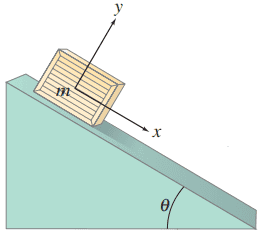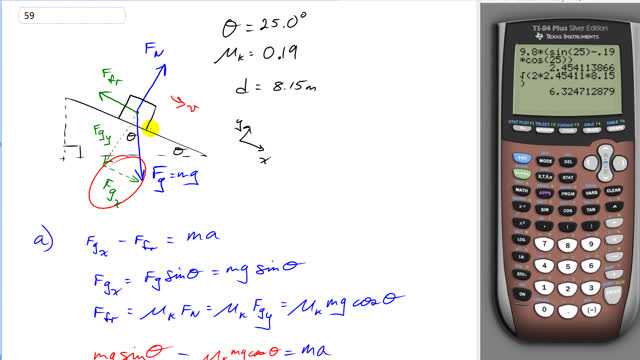
The crate shown in Fig. 4–60 lies on a plane tilted at an angle to the horizontal, with .
- Determine the acceleration of the crate as it slides down the plane.
- If the crate starts from rest 8.15 m up along the plane from its base, what will be the crate’s speed when it reaches the bottom of the incline?


In order to watch this solution you need to have a subscription.
This is Giancoli Answers with Mr. Dychko. This crate is being accelerated down the ramp by this component of gravity that's along the ramp in the x direction because we have these coordinates tilted so that the positive x axis goes down the ramp and positive y is perpendicular to the ramp upwards. And we have friction working up the ramp resisting in the opposite direction to the velocity, that's kinetic friction. The ramp has an angle of 25 degrees, coefficient of kinetic friction is 0.19. And for part B we'll ask what the final speed of this crate would be after it travels 8.15 meters along the ramp. So, first we'll find the acceleration of the crate and the component of gravity in the x direction down the ramp minus the force of friction up the ramp, together makes the net force along the x axis. And so, that makes it equal to ma by Newton's second law. And Fgx is the opposite leg of this triangle here. So, we use sine theta times Fg which is mg, to calculate Fgx. And then we'll find, we have an expression for the force of friction as well, it's the coefficient of kinetic friction times the normal force. And the normal force is the only force in the positive y direction, and since there's no acceleration perpendicular to the ramp the normal force has to equal the total forces on the negative y direction of which there's only one, this component of gravity in the y direction so, I'm kind of saying things in sort of a wordy way so that you can think of it this way for more complicated questions, where there might be maybe a hand pressing on the box in which case the normal force would equal the component of gravity perpendicular to the ramp plus the hand force, and things like that. You can't always just say, the normal force equals the component of gravity but perpendicular because it's not always true. It just happens to be true in this picture but... So, we have friction force muK FN. FN is Fgy and Fgy is mg cos theta because it's the adjacent leg of this triangle. So, it's cosine theta and then multiply force of gravity, mg. And then we comes up to do both of those into our in second law so, we have Fgx is mg sine theta. And then we have force of friction is muK mg cos theta equals ma. And we'll solve that for a. So, we have a equals g bracket sine theta minus muK cos theta. So, we divided everything by m and then factored out the g just to be slick and makes it look cleaner. So, we have 9.8 meters per second squared times sine of 25 degrees minus coefficient of kinetic friction, 0.19, times cos 25. Gives 2.5 meters per second squared is the acceleration of the crate down the ramp. And what will be the final speed when it reaches the bottom of the ramp? Well, it starts with an initial speed of 0. So, we have VF squared equals 2ad, then take the square root of both sides and we have the final speed will be the square root of 2 times the acceleration times the displacement. So, square root of 2 times 2.4511 meter per second squared acceleration times 8.15 meters which gives 6.3 meters per second as a final speed. Two significant figures since this acceleration has two significant figures.
Why don't you use the distance of the inclined plane (hypotenuse) in part b? Shouldn't we use acceleration (which I think we made it to a horizontal component) and the distance of the same plane?
Oh, I'm sorry. I misread the question as the height of the crate before release is 8.15m.